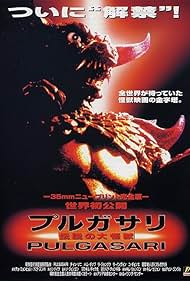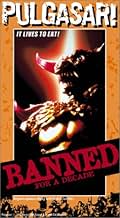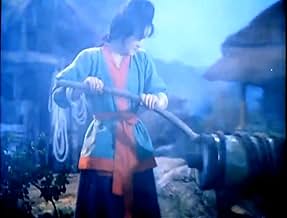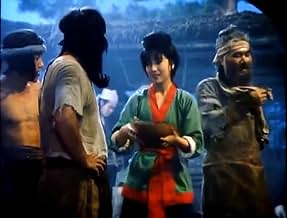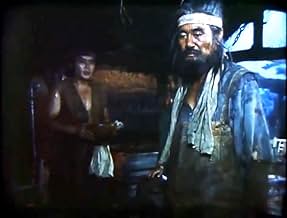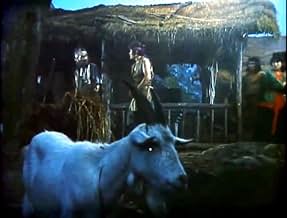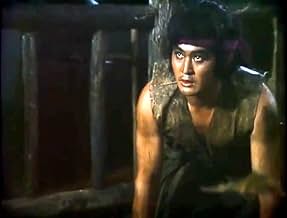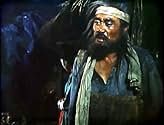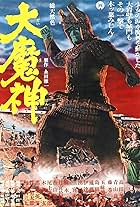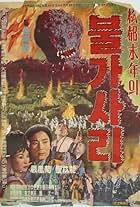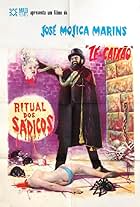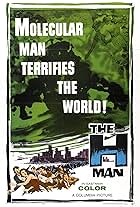Pulgasari
- 1985
- 1h 35m
IMDb RATING
5.2/10
1.4K
YOUR RATING
In feudal Korea, a group of starving villagers grow weary of the orders handed down to them by their controlling king and set out to use a deadly monster under their control to push his armi... Read allIn feudal Korea, a group of starving villagers grow weary of the orders handed down to them by their controlling king and set out to use a deadly monster under their control to push his armies back.In feudal Korea, a group of starving villagers grow weary of the orders handed down to them by their controlling king and set out to use a deadly monster under their control to push his armies back.
- Director
- Writer
- All cast & crew
- Production, box office & more at IMDbPro
Featured reviews
first of all, its unfair to compare this movie with a Hollywood product: this is an eastern "man-in-rubber-suit" monster movie made in north Korea and must be evaluated as such. and in his niche this is one of the very best. for the originality and meanings it deserves to be put on the same level of Honda's Godzilla of 1954. it sports believable effects, real mass scenes (ok they were soldiers drafted to act in a movie but nevertheless it's better than what i've seen in "Gappa") and believe it or not a plot that is less nonsense than the usual Gamera - Rodan - Godzilla - Gappa stuff we got used to. at least all the story is more fantastic than Sci-Fi and this places everything on a completely different perspective. "comedy" episodes are laughable but i suppose that asking to a North-Korean movie to meet the standard humor tastes of a western audience is way too much. the interpretative key of the story revolves around the goods and evils of capitalism ,one may appreciate or not the intentions but go find another Kaiju with more sense than "the Japanese are still scared after the atom bomb, poor souls", and "the Japanese scientists save the world". Pulgasari is finally less nationalistic than the average Japanese movie, and this is outstanding for a product of a dictatorial country, isn't ?
A lot of people here might not be familiar with one of my favorite pages on the entire Internet, Wikipedia's list of unusual articles. It's just a collection of weird stuff that this very movie happened to be featured on. I actually first heard about this film when watching a segment with Lewis Black on "The Daily Show". It's very hard to talk about this film at all without explaining its backstory. It was actually made when Kim Jong-Il kidnapped a movie director. Yep, this guy was actually a fan of movies and probably would have himself made a good Bond villain in real life. For a propaganda film, this didn't really have that much that was offensive in it.
It's still a pretty dumb movie as it features a toy monster that comes alive when blood gets on it. The monster grows when eating iron. It's very silly, but it's really no dumber than most of the films in the Gamera series. North Korea is known for knockoff products, but this really wasn't one. It seems like every country has done a kaiju movie. Pulgasari is actually a mythical figure so it's no Godzilla ripoff. The colors in this film are just plain gaudy. Some of the action scenes really aren't that bad. It is very hard to enjoy something that was forced. Imagine if people could kidnap those who worked on their favorite franchises like "Pokémon" or "Doctor Who". George Lucas would be cliché. It's still a shame the Kim family has yet to be put to justice. Oh, and this is all the fault of religion, according to Richard Dawkins and Bill Maher. Yeah, it's hard not to get political when talking about this. **
It's still a pretty dumb movie as it features a toy monster that comes alive when blood gets on it. The monster grows when eating iron. It's very silly, but it's really no dumber than most of the films in the Gamera series. North Korea is known for knockoff products, but this really wasn't one. It seems like every country has done a kaiju movie. Pulgasari is actually a mythical figure so it's no Godzilla ripoff. The colors in this film are just plain gaudy. Some of the action scenes really aren't that bad. It is very hard to enjoy something that was forced. Imagine if people could kidnap those who worked on their favorite franchises like "Pokémon" or "Doctor Who". George Lucas would be cliché. It's still a shame the Kim family has yet to be put to justice. Oh, and this is all the fault of religion, according to Richard Dawkins and Bill Maher. Yeah, it's hard not to get political when talking about this. **
Since I began living in South Korea several years ago, I have always been curious about what life and art would be like in the isolated North. The educational channel in South Korea (EBS) has a weekly show that gives us clips of North Korean newscasts, movies, music, dramas and animation.
When South Korean president, Kim Dae-jung visited North Korea last year in the first step toward normalizing relations and possible (albeit future) unification, we learned that the North Korean supreme leader is something of a movie fanatic. He has been secretly receiving western movies and monitoring South Korean tv dramas. It is not surprising to learn that he apparently ordered Pulgasari be made. Like every other artform from the North it can only be broadcast or shown if it matches the philosophy of the state. Pulgasari is a metaphor. The evil king represents the feudal government of the Chosun Dynasty which ended at the beginning of the 1900's. The monster, Pulgasari represents capitalism. It arrives apparently to help the people, but soon grows out of control. The heroes in the movie are the peasantry, the common people who must fix everything that people with power have wrought.
Nobody can claim that Pulgasari is state-of-the-art. Even by rubber monster standards, this movies special effects are poor. It does help to consider that the budget for this movie was probably around what we spend on lunch in a year. But for me, the true fascination of a movie like this is the chance to see how another culture, living under a completely different philosophy, sees the world.
When South Korean president, Kim Dae-jung visited North Korea last year in the first step toward normalizing relations and possible (albeit future) unification, we learned that the North Korean supreme leader is something of a movie fanatic. He has been secretly receiving western movies and monitoring South Korean tv dramas. It is not surprising to learn that he apparently ordered Pulgasari be made. Like every other artform from the North it can only be broadcast or shown if it matches the philosophy of the state. Pulgasari is a metaphor. The evil king represents the feudal government of the Chosun Dynasty which ended at the beginning of the 1900's. The monster, Pulgasari represents capitalism. It arrives apparently to help the people, but soon grows out of control. The heroes in the movie are the peasantry, the common people who must fix everything that people with power have wrought.
Nobody can claim that Pulgasari is state-of-the-art. Even by rubber monster standards, this movies special effects are poor. It does help to consider that the budget for this movie was probably around what we spend on lunch in a year. But for me, the true fascination of a movie like this is the chance to see how another culture, living under a completely different philosophy, sees the world.
Filmed in 1985 by a director (Sang OK Shin) who had been kidnapped by North Korea, this movie is about a monster who is created by a blacksmith just prior to his death to help his village against an evil king. Now from what I understand Kim Jong Il (the eventual leader of North Korea) was an avid movie buff and wanted Sang OK Shin to produce a film along the lines of "Godzilla". This movie is the final product. Unfortunately, this movie doesn't translate as well to world-wide audiences as its famous predecessor did. That's not to say that this movie is necessarily bad but it clearly had some weaknesses. For starters, the special effects were quite poor and the movie had some scenes which could have definitely been trimmed here and there. Along with that the movie I saw was filmed in Korean but had English subtitles. I only mention this because this is a film that is probably best suited for young children and subtitles simply won't suffice for that particular audience. Be that as it may I rate the movie as slightly below average.
In the days of feudal Asia, the crops are not so good, and farmers are facing a takeover by Jong-Un Kim ... oops the self-proclaimed king (Yong-hok Pak.)
The farm Jugend becomes rebels and with the help of the local blacksmith physically challenges the king.
The king offers the blacksmith employment by supplying his army with weapons. Naturally, the blacksmith refuses. While he is imprisoned his last dying, wish is to make a revengeful "iron eating" Pulgasari.
Eventually, the king may meet the same fate as Bambi Meets Godzilla .
The big question is will any of the good guys survive?
Or will the world go to the peasants?
The film was loosely based on the legend of the Bulgasari.
The value in the movie is not the movie it is self but the historical value.
On the orders of Kim Jong-il, the South Korean film director Shin Sang-ok (1926-2006) and his wife, famous actor Choi Eun-hee, was kidnapped to North Korea.
After three years in prison, Shin was united with Choi, and the two were instructed by Kim Jong-Il to make films for him to gain global recognition in the film industry. After making various films for Kim Jong-Il, including Pulgasari in 1985, in 1986 Choi and Shin escaped from North Korean caretakers to a US embassy while in Vienna.
The Lovers and The Despot.
The farm Jugend becomes rebels and with the help of the local blacksmith physically challenges the king.
The king offers the blacksmith employment by supplying his army with weapons. Naturally, the blacksmith refuses. While he is imprisoned his last dying, wish is to make a revengeful "iron eating" Pulgasari.
Eventually, the king may meet the same fate as Bambi Meets Godzilla .
The big question is will any of the good guys survive?
Or will the world go to the peasants?
The film was loosely based on the legend of the Bulgasari.
The value in the movie is not the movie it is self but the historical value.
On the orders of Kim Jong-il, the South Korean film director Shin Sang-ok (1926-2006) and his wife, famous actor Choi Eun-hee, was kidnapped to North Korea.
After three years in prison, Shin was united with Choi, and the two were instructed by Kim Jong-Il to make films for him to gain global recognition in the film industry. After making various films for Kim Jong-Il, including Pulgasari in 1985, in 1986 Choi and Shin escaped from North Korean caretakers to a US embassy while in Vienna.
The Lovers and The Despot.
Did you know
- TriviaAlthough the film is a North Korean production, director Shin Sang-ok is South Korean. North Korean dictator Jong-Il Kim was a huge fan of Shin's. At the time this film was made, North and South Korea were at war (which eventually ended in 2018 thanks to the Panmunjom Declaration). Thus, Kim had him kidnapped. Shin eventually escaped back to South Korea, but not before he had been forced to make this movie for the erratic North Korean leader.
- ConnectionsFeatured in Great Man and Cinema (2009)
- How long is Pulgasari?Powered by Alexa
Details
Contribute to this page
Suggest an edit or add missing content

